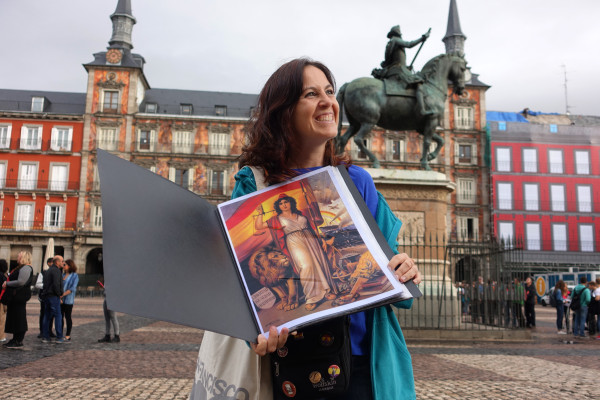
Dr. Almudena Cros stands in the center of the Plaza Mayor, the 17th century centerpiece of old Madrid. She opens a large portfolio and turns the pages to a photo from 1931.
King Alfonso XIII had just abdicated the throne and a crowd of over excited citizens have just toppled the 17th century statue of the King Philip III off his pedestal to the stone pavement below. The statue was reinstated. King alfonso XIII was not. It was the beginning of the Second Spanish Republic.
Alfonso XIII was the son of Alfonso XII, the King who reinstated the monarchy in 1874 after the First Spanish Republic, a one year interruption that could never get the various political fronts to agree to anything.
Spain was the most successful global empire of the 17th and 18th centuries with territories in Europe, North America, South America, Africa, Middle East and Asia. Nevertheless, by 1833, most of the territories in North and South America were lost to wars of Independence. In 1899, Spain lost the Philippines in the Spanish American War. By the time Alfonso XIII came to power in 1886, there really wasn’t much left of the Spanish Empire. Without the wealth from the colonies, money dried up. However, the bellies of the rich still needed to be fed. They took it wherever they could, usually from the poor. The winds of social and economic change were blowing hard across Spain.
In 1931, King Alfonso XIII abdicated, or literally fled for his life and the Spanish Republic was born, voted in by the country’s educated, working class and poor. Women received the right to vote after the Republic was established.
In order to increase the standard of living for the entire country, the Republic needed to reduce the outdated benefits of the wealthy class, the military and the Church. Of course, these classes were not so eager to give up their extravagant lifestyles.
By 1939, the Republic was over, defeated by the deceptions of Roman Catholic priests, the Fascist forces of Generalissimo Francisco Franco and military support of Germany and Italy. Nearly 500,000 people died during the conflict, close to 200,000 of them in combat. The Spanish Civil War was the training ground for Hitler and Mussolini before the start of World War II.
Almudena Cros closes her portfolio and leads her group of visitors on to the Puerta del Sol and the Gran Via, the pulsing heart of modern Madrid. The 19th century Neo-Mudejar, Secession and Art Deco buildings soar majestically above the ancient streets, their 78 year old battle scars have been cosmetically repaired.
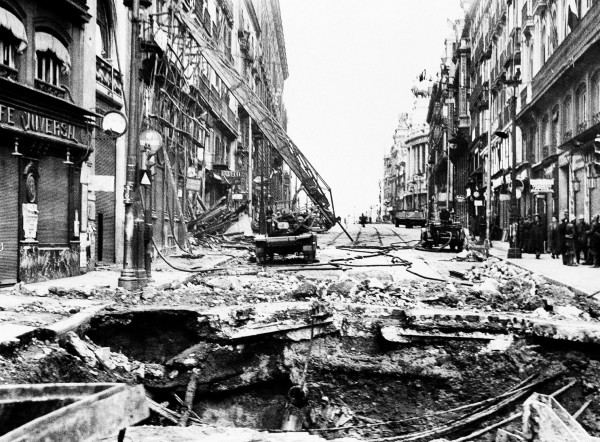 Almudena shows her tour group some photos of the same buildings and streets from 1937. The images show a burned out, bombed out disaster. She continues with stories of the war, stories of Ernest Hemmingway, Martha Gelhorn, George Orwell and Antoine de Saint-Exupéry, all who all came to Spain to help the Republican Rojos (reds), stories and images of war photographers Robert Capra and Gerda Taro, the first female war photographer who died during the Spanish Civil War while helping the wounded of the Republican Army, stories of the over 40,000 international volunteers of the International Brigades, stories of the brave and the suffering, stories handed down from her grandmother and her grandfather who served in the Republican army.
Almudena shows her tour group some photos of the same buildings and streets from 1937. The images show a burned out, bombed out disaster. She continues with stories of the war, stories of Ernest Hemmingway, Martha Gelhorn, George Orwell and Antoine de Saint-Exupéry, all who all came to Spain to help the Republican Rojos (reds), stories and images of war photographers Robert Capra and Gerda Taro, the first female war photographer who died during the Spanish Civil War while helping the wounded of the Republican Army, stories of the over 40,000 international volunteers of the International Brigades, stories of the brave and the suffering, stories handed down from her grandmother and her grandfather who served in the Republican army.
The next stop on the tour is to Ciudad Universitaria, University City, home of the Complutense University of Madrid. During the 17th and 18th centuries the University was one of the leading centers of learning in the world. Albert Einstein accepted a post here in 1933 but due to the impending war, he changed his mind and took a post at Princeton. It currently enrolls over 86,000 students.
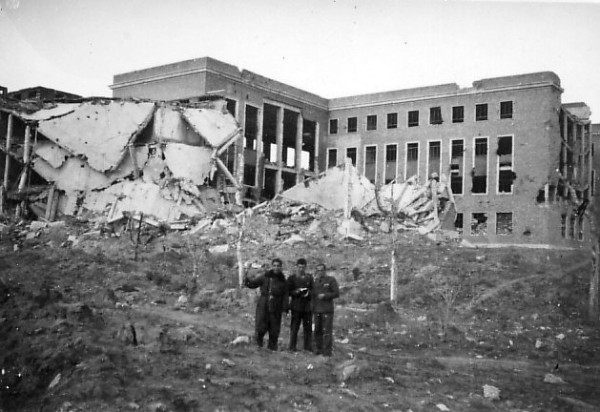 In November 1936, a few years after barely half of the newly constructed buildings of the University were completed, the worst confrontation between the International Brigades and the Fascist troops tore the campus apart.
In November 1936, a few years after barely half of the newly constructed buildings of the University were completed, the worst confrontation between the International Brigades and the Fascist troops tore the campus apart.
It was a baptism of fire for the Internationals who had just arrived to the fight. Much of the fighting was hand to hand, grenade and bayonet, room to room.
The University buildings are still pockmarked and scarred with shrapnel and bullet wounds. After the war, the Franco government did rebuild the University but it’s not a very good restoration. It’s possible the shoddy repairs were meant to be an insult to school, kind of a backhanded gift to the intellectuals he hated during the conflict.
The blown out walls of once perfectly pointed golden brick were replaced with an unfinished basement foundation brick.
Almudena asks a passing group of students if they know why the granite foundations are so disfigured and marred. The students shrug and say no. They have no idea. “This is a very common response,” she explains to her tour group. When Spain buried the dead, it seemed as if they buried all memory of the war.
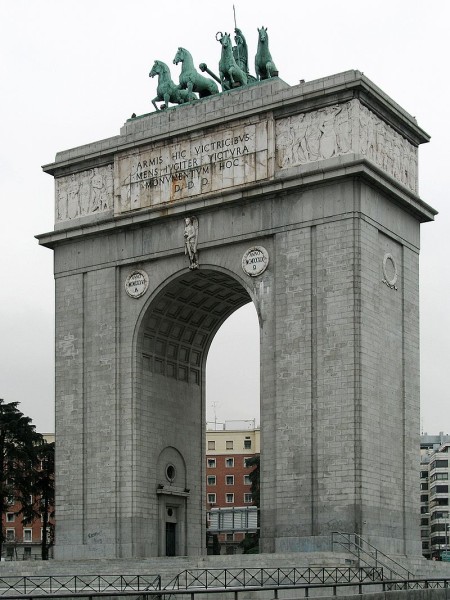 In 1956, Franco unveiled the Arco de la Victoria, a 132’ tall triumphal arch commemorating the Fascist victory in the Battle of University City. Latin inscriptions proclaim the victory and the rebuilding of University City. Even Franco was able to spin a bad reconstruction into a great victory.
In 1956, Franco unveiled the Arco de la Victoria, a 132’ tall triumphal arch commemorating the Fascist victory in the Battle of University City. Latin inscriptions proclaim the victory and the rebuilding of University City. Even Franco was able to spin a bad reconstruction into a great victory.
They western powers gave no support to the Republican Democracy of Spain. If the United States or the United Kingdom or France gave military support to the Spanish Republic in 1936, they would have defeated Franco’s Fascist revolt and consequently defeated the armies of Hitler and Mussolini. In other words, World War II might have never happened.
History is constantly questioned with ‘what if’ scenarios. It is a controversial science, often revised to benefit of the powers in office.
In a modern world where talk shows and fabricated news control every minute of every day, we are filled with controversial political wingnuts spewing the most ridiculous political points of view and historical inaccuracies one could ever imagine. Fact and fiction are blended into a history that never happened.
George W. Bush, possibly the worst US President of the history of the country, said, “History will ultimately judge the decisions that were made.” He’s right. Future administrations in the US could spin the mismanagement of his Presidency onto his opponents. Bush led the United States into 2 wars and crippled the economy and yet, his conservative political party is still trying to convince the world all these problems were a result of the liberals.
Napoleon is quoted to have said, ‘History is a set of lies that people have agreed upon.’ He was right. History is often rewritten by those in power.
In 1937, at the request of Franco, the Basque town of Guernica was attacked by the German and Italian air forces, the first use of carpet bombing. The city was destroyed and the Basque region fell into the hands of the Nationalists. Franco tried to spin the story claiming the fleeing Republicans destroyed the town and all of it’s resources (food, communications and resources) to keep them from the approaching Nationalists. It didn’t work. The only people who believed the his story were the Nationalist supporters. Guernica is immortalized as one of the worst military raids on a civilian population and a very black mark in the legacy of Francisco Franco.
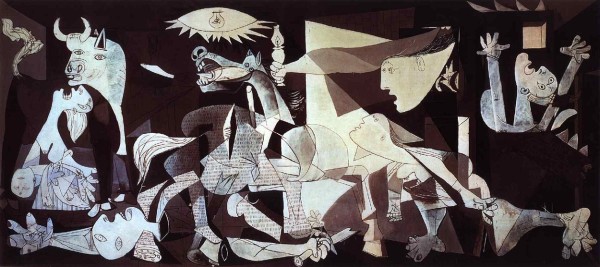 One month after the bombing, Pablo Picasso began working on his painting of the horror of what happened in Guernica. The 25′ long by 11′ tall painting was created for the Republican Spanish Pavilion at the 1937 World’s Fair in Paris. At the end of the World’s Fair, Picasso refused to let it ever go to Spain as long as Franco was in power. It was loaned to the Museum of Modern Art in New York for safekeeping. In 1981 the painting finally returned home to Spain. It is currently on display at the Museo Nacional Centro de Arte Reina Sofía, Madrid’s museum of 20th century art. The painting has since become the symbol of human suffering and the horrors of war.
One month after the bombing, Pablo Picasso began working on his painting of the horror of what happened in Guernica. The 25′ long by 11′ tall painting was created for the Republican Spanish Pavilion at the 1937 World’s Fair in Paris. At the end of the World’s Fair, Picasso refused to let it ever go to Spain as long as Franco was in power. It was loaned to the Museum of Modern Art in New York for safekeeping. In 1981 the painting finally returned home to Spain. It is currently on display at the Museo Nacional Centro de Arte Reina Sofía, Madrid’s museum of 20th century art. The painting has since become the symbol of human suffering and the horrors of war.
There is a famous story about Picasso during the time he was living in Paris during World War II. A German officer noticed a photograph of Guernica hanging on a wall of his apartment. The officer asked Picasso, “Did you do that?” Picasso replied, “No. You did.”
It has been almost 80 years since the eruption of the Spanish Civil War. Franco ruled for 36 years until his death in 1975 when Spain finally regained a Democracy. However, after the war, the Spanish people followed the path of ‘El Pacto de Olvido’, the pact of forgetting. It was much easier to forget than to deal with the legacy of Francisco Franco.
It’s estimated that over 400,000 Republicans spent time in prisons or forced labor camps after the war. Many of them were tortured and executed, many of them without the due process of a trial. The pact ensured there were no prosecutions for anyone responsible for death or destruction during the Civil War or the Franco regime.
In 2007, the Spanish government passed the Historical Memory Law, granting victims of the war and the dictatorship compensation and basically condemning the Franco Regime. Of course, the law was met with controversy both from the conservative right who feel the law is just political propaganda and the liberal left who feel the law doesn’t do enough.
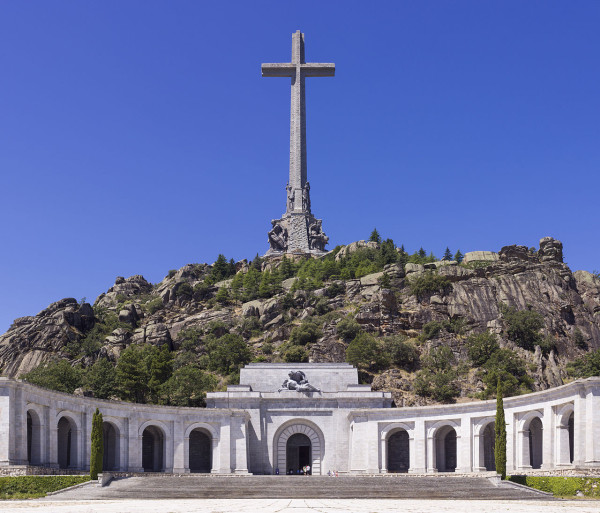 About 10km northeast of El Escorial, the home of the Royal Kings of Spain, is the Valle de los Caidos (Valley of the Fallen). It is the War memorial built by Franco and the Catholic Church. It was intended as a monument dedicated to atonement and reconciliation but it has always been considered a monument to Franco and the Fascists. Around 10% of the labor force (close to 300 workmen) were political prisoners from the Franco prison camps. It took 18 years to complete the project. Over 30,000 casualties of war, Republican and Nationalist were moved here between 1940 and 1959. Franco himself was buried here in 1975.
About 10km northeast of El Escorial, the home of the Royal Kings of Spain, is the Valle de los Caidos (Valley of the Fallen). It is the War memorial built by Franco and the Catholic Church. It was intended as a monument dedicated to atonement and reconciliation but it has always been considered a monument to Franco and the Fascists. Around 10% of the labor force (close to 300 workmen) were political prisoners from the Franco prison camps. It took 18 years to complete the project. Over 30,000 casualties of war, Republican and Nationalist were moved here between 1940 and 1959. Franco himself was buried here in 1975.
It is still one of the most visited places in Spain but as long as Franco is buried here, it will always stand for brutality of his war and his government. The 2007 Historical Memory Law now forbids any political events to take place here.
In 2011, commemorating the 75th anniversary of the war, the Asociación de Amigos de las Brigadas Internacionales erected a monolithic monument to the fallen soldiers of the International Brigades during the battle of University City. This is the only memorial to the Republican fallen erected in Spain. A short time after the inauguration, the monument was vandalized with red paint and the word ‘Asesinos’ (assassins) painted across it. There is still a lot of hatred between the Republicans and the Nationalists. Granted, both sides committed brutal acts against each other.
Through her website, insights and personal guided tours, Almudena strives to give recognition to the memory of those who died so bravely for their independence, giving them the peace they deserve. She is a flame of enthusiasm, armed with portfolios of photos, pouches of props and thought provoking tales that take you on a cinematic, theatrical journey through the history of Madrid. This is her city. She was born here. She hope to erase the Francoist propaganda and let the truth come out. After almost 80 years, it’s time.
Almudena has consulted on Pulitzer Prize author Richard Rhodes book, ‘Hell and Good Company’. She has been aiding filmmaker Peter Davis in his return to the people and country of Hemingway’s 1936 film ‘Spanish Earth’. Davis’ film project, ‘Digging Spanish Earth’, looks at the people and places of the film 80 years later.
She also serves as the President of the non-for-profit ‘Association de Amigos de las Brigadas Internacionales’, Friends of the International Brigades
Dr. Almudena Cros is a PhD Art Historian who has studied in England, Italy, Germany and Spain and is fluent in Spanish, English and Italian. She currently teaches Art History at Suffolk University in Madrid but her passion for the history of Madrid is much too grand to contain inside the confines of a classroom.
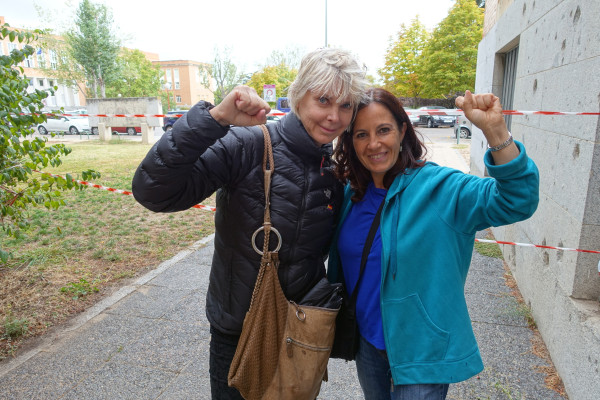
Other tour guides have copied Almudena’s Spanish Civil War walking tour. Over 8 million tourists come to Madrid every year. There are many tour companies. In some ways it’s good that they are promoting the history of this tragic time in Spain. However, they don’t have the history, the passion or the patrimonial connection of Almudena Cros.

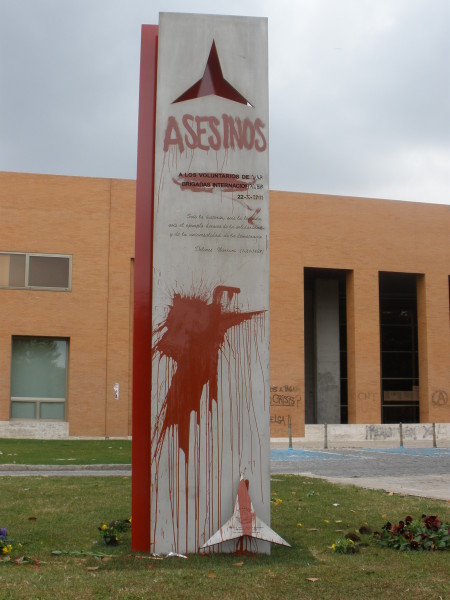
You must be logged in to post a comment.